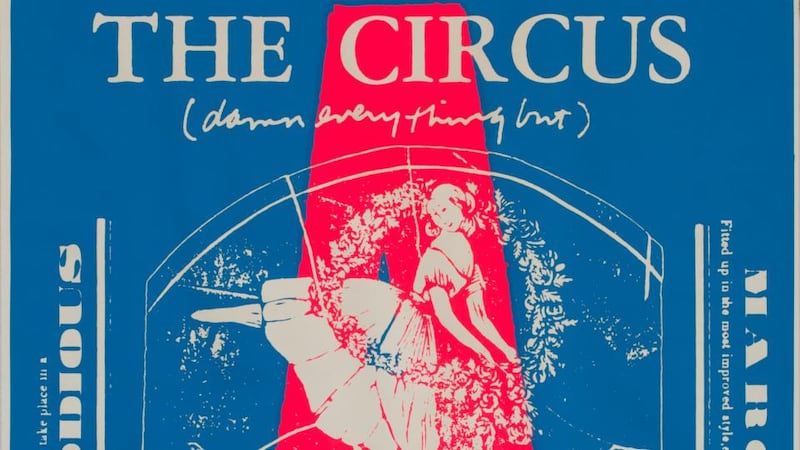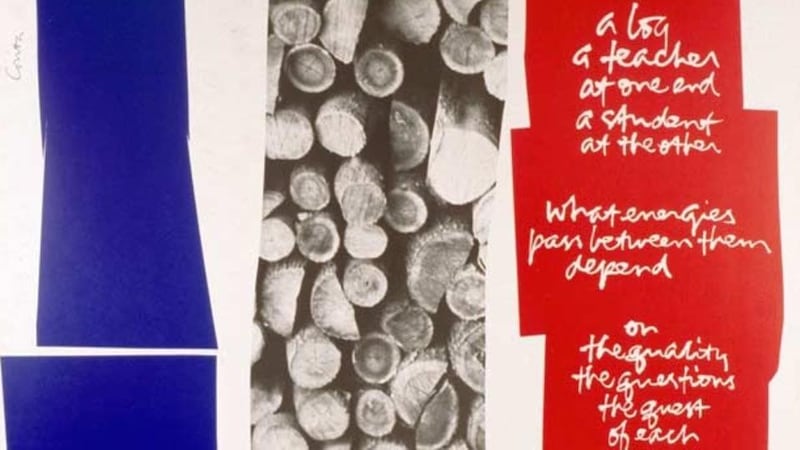The campus buildings oat LA’s Immaculate Heart College are decorated with huge, colourful posters of food – rows of shiny, stylised apples and pears, giant labels from canned peaches, supermarket price tags magnified a hundred times.
Students and their teachers (the latter group mostly nuns and priests) have decorated their hair and draped their clothes with garlands of poppies, roses and dahlias. They picnic, wave balloons and sing and dance in circles on the grass, in the sunshine, to celebrate the Virgin Mary, to celebrate food, and to remember the people who go hungry.
The scene is from Mary's Day 1964, a short documentary film being screened at the Douglas Hyde Gallery 2 in Trinity as part of Corita, an exhibition of prints and posters by the late Corita Kent.


Kent, described as “Warhol with a conscience”, was a pop artist, an influential art teacher – and a nun for 32 years in a Hollywood convent before she left to become a full-time artist.
Mary's Day (or the Feast of the Blessed Virgin, as it was called here – the difference in titles speaks volumes) was shot at the Californian college at the time of Lyndon B Johnson's so- called war on poverty.
It was the beginning of the flower children, before Altamont, before Manson. Watching it now, you marvel at the idealism. It shows how radical Kent was, and at the same time how much a product of her time and place.
Like Warhol, she co-opted the everyday graphics on the packaging of US consumer goods, but, influenced by the anti-war and civil-rights movements of the 1960s, she subverted them in order to underline the importance of social justice and creativity and community.
She made hundreds of screen prints to communicate her message as widely as possible, as a way to “invigorate and inspire all people who have to live with the onslaught of advertising”.
Mostly made in bold, primary colours, almost all her work incorporated bits of text. She loved the word – in every sense. It was she who made the poster that read: “Today is the first day of the rest of your life.” Others had quotes from diverse sources, including Ralph Waldo Emerson, Albert Camus, EE Cummings, The Beatles and the Bible.
“I always loved lettering,” she said, “the shape of letters and different types and fonts. And I like that they have two functions: one is the visual function, that linear quality, and then of course they also add meaning.”
For her, “putting words with images is as natural as putting words with music”.
Left-leaning clergy
She was friends with some left-leaning American clergy of the 1960s – back in pre-scandal times – including high-profile anti-Vietnam protesters such as Daniel Berrigan. She was also friends with artists Charles and Ray Eames, and Buckminster Fuller.
Mentored by the art department’s iconoclastic Sr Magdalen Mary, Corita was determined to shake things up and break with the rigid traditions of the 1950s, which dictated that students spend much of their early training copying the Old Masters. Instead she brought them down to used car lots or into supermarkets and had them look at what was around them.
“Her classes were wild,” enthuses one former student in the film. “It was a kind of creative free-for-all.”
Encouragement
Kent got support and encouragement from her fellow nuns in what she described as a “crucible of creativity” within the college. She believed creativity was for everyone, and loved the Balinese saying, “We have no art. We do everything as well as we can.”
Not that it was all folk Masses and “ban the bomb” marches in LA, even afterthe second Vatican Council. The conservative cardinal James Francis McIntyre was none too pleased with Sr Corita and her fellow sisters, especially when they began agitating to be allowed to wear civilian clothes. Nor was he happy that Kent had become a minor celebrity of sorts – she went on lecture tours and organised “happenings”.
Much of 1967 and 1968 was spent in a stand-off with the church. Eventually, in 1968, Kent left the convent and moved to Boston to paint full time. She became a successful commercial artist, and designed, among other things, a 1985 Love stamp for the US postal service. Her work is held in the collections of the Whitney Museum of American Art and New York’s Metropolitan Museum of Art.
In 1974, she was diagnosed with cancer, and died 12 years later. She spent much of her last two years campaigning against nuclear weapons.
Kent is increasingly cited as an influence by young contemporary artists, such as the German artist Andrea Büttner and the Glasgow-based Canadian Ciara Phillips, who was nominated for the Turner Prize this year and had a co-exhibition of her work along with Kent’s in Bristol in 2012.
Half a century on, it seems Corita is cool again.
Corita runs in Gallery 2, Douglas Hyde Gallery, Trinity College Dublin, until July 30. It includes many examples of Kent's prints and posters that, in keeping with the artist's ethos, will be distributed in a free raffle at the end












